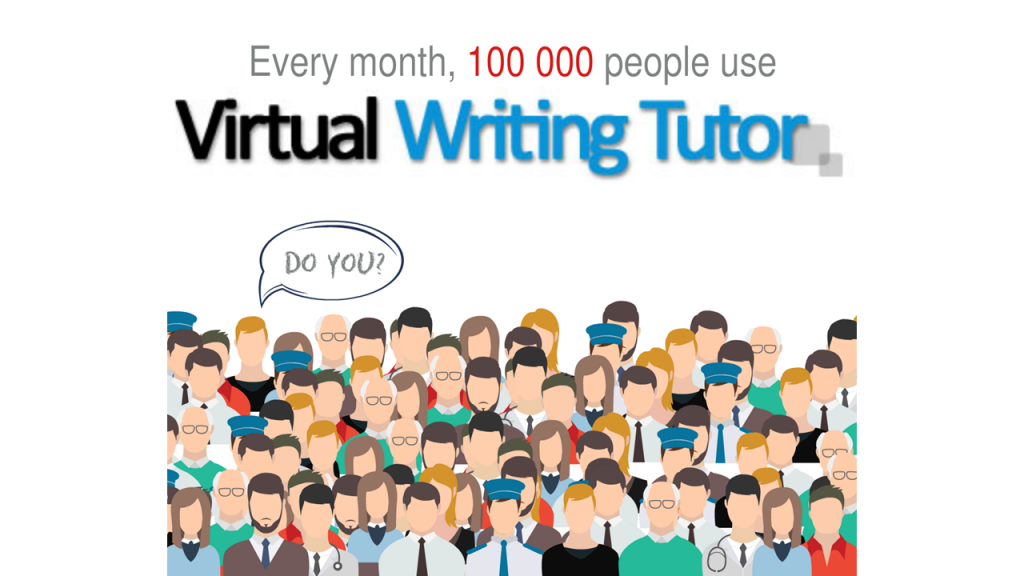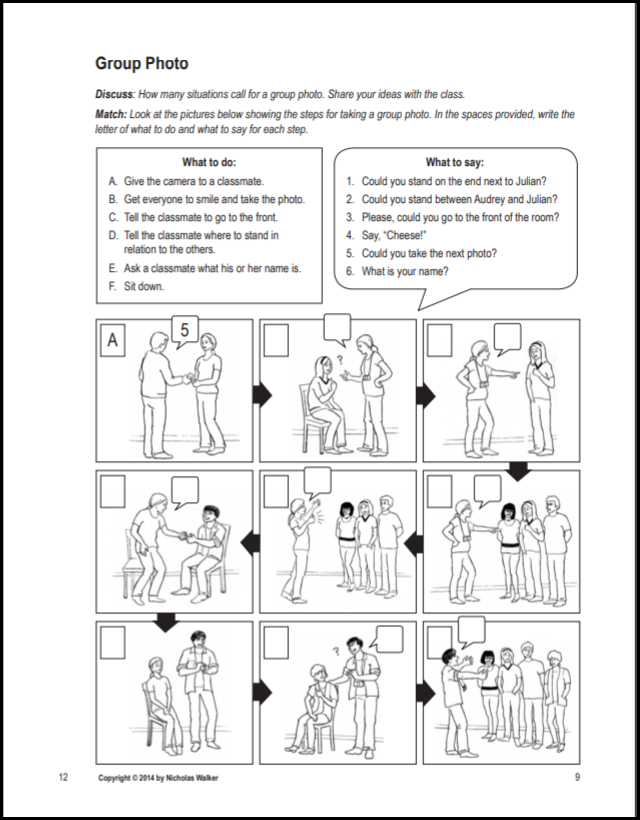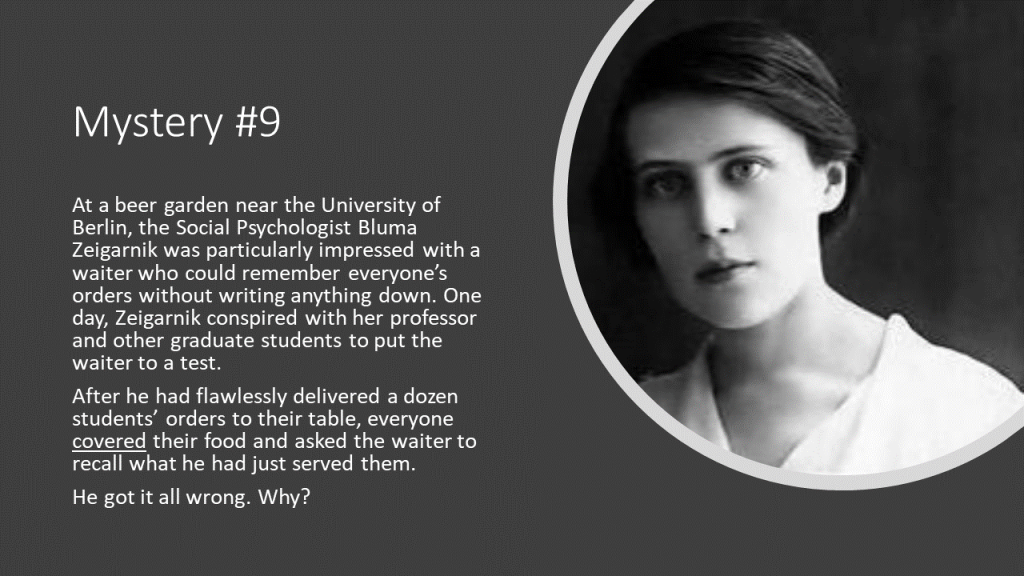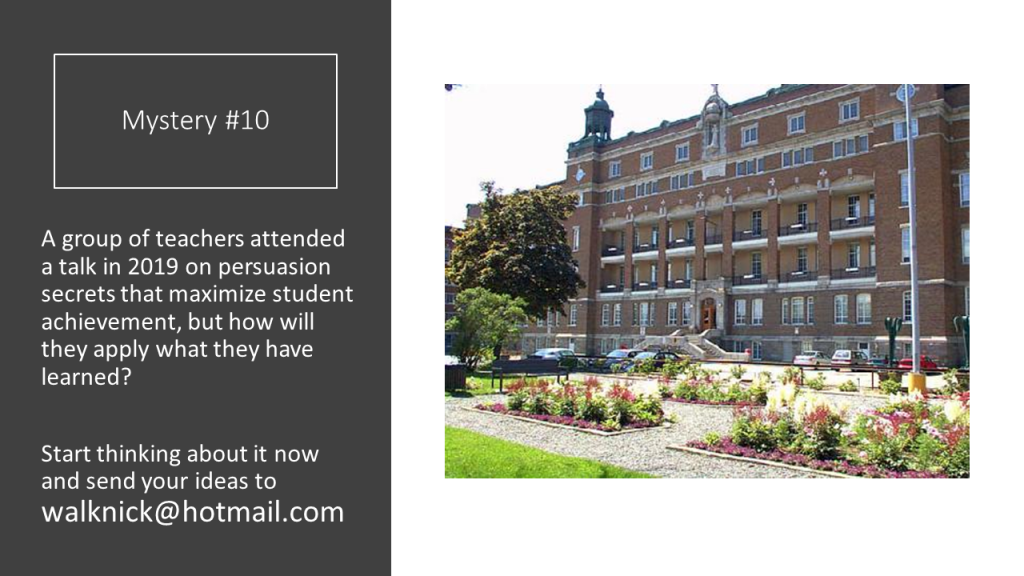We all want our students to succeed, but sometimes we encounter resistance. If we could persuade students to cooperate with us sooner without having to resort to rewards and threats, we might be able to get better results, right?
Here are some sneaky persuasion secrets that marketers and advertisers use to influence behaviour. Teachers can learn them too and get better results from their students.
As you read below, you will notice that I have inserted images of PowerPoint slides that contain mysteries to solve. The mystery itself is a persuasive technique because it engages the audience’s curiosity. Students who are curious about what is coming next will listen carefully to your message. Attentive listening is, after all, a form of cooperation.
Create Persuasive Introductions
The first thing teachers should learn to do is to introduce themselves in a persuasive way. At the beginning of a semester or a lesson, it is important to get students to listen, trust and commit to cooperating with you. Here is an example of a series of comments intended to get conference goers on-side.

Of course, you will have your own script as a teacher, but it is wise to think about structuring your introduction in a way that will make them want to trust you and cooperate with you over the weeks to come.

Liking
Begin presentations and lessons by complimenting your audience. Compliments build trust. More important that getting your students to like you is demonstrating that you like them. People assume that those that like and admire them always have their best interests at heart.
Unity
Show support for a universally popular issue to unify with the group. A cohesive group will support its members.
Credibility
Build credibility by admitting to a weakness before mentioning a strength.
Authority
Share your credentials to establish your authority.
Goals
Tell people what you want, and then give them the steps they will need to take to achieve that goal.
Commitment and Consistency
Get them to commit to something early on to trigger consistency. People will want to remain consistent with prior decisions they made, especially when they make them publicly.
Ask students the following. You’ll do your homework this week, right? [Pause for confirmation.] Great! Thanks! Participation rates increase from 70% to 82.4% when phone operators wait for confirmation.
Social Proof
Demonstrate the popularity of your ideas with social proof. Get everyone to raise their hands and then look around the room at the universal support for your ideas or request.
Pedagogical Persuasion Tips
Ask individual students to let you hold their cell phones. This will elicit an initial commitment to trust you. It will also demonstrate to onlookers that you are trustworthy.

You can do this casually as you walk around the class, giving feedback during an activity. Students won’t realize that you are helping them associate you with an inclination to trust. It can backfire if you ask someone to look at their phone and they refuse. Onlookers might associate you with distrust. Usually, it works.

Asking “Do you consider yourself a helpful person?” prior to asking him or her for help increased the likelihood of survey respondents to agree to help. Priming the notion of “helpful” before making your request for help can increase compliance.

If you want someone to take a risk, plant the idea of adventurousness in their heads prior to asking them to do something risky. Being adventurous is a positive form of risk taking. Thinking about being adventurous will make the risk you want them to take seem positive.

Putting the picture of someone winning a race at the top of fundraising script inspired fundraisers to work harder and focus on achievement.
You can get your students to focus on achievement by asking students to write down the names of famous bilinguals. They will aspire to be like them. Research shows that girls do better in math when they see pictures of successful female mathematicians in exam rooms or on the cover of their exam booklets.
Instead of thinking about heroes to motivate students to achieve, you can get students to describe successful moments in their lives and their academic successes. It, too, will orient them toward future successes.

Pavlov could get dogs to salivate at the sound of a bell–but not when there were journalists in the room. The change in the dogs’ environment blocked associations from having their usual effect on them.
Flip the lights to interrupt activities. Changes in the environment trigger an investigatory reflex (a.k.a. an orienting response). Students will stop talking to investigate why the lights are flashing. There are other elements in the environment that can compete for students’ attention.

Avoid decorating your classroom. Highly decorated classrooms interfere with learning and cause students to learn less.

Researchers have found that general daily prayers have no effect on fidelity rates among Christians. However, praying for their partner’s welfare every day has a big effect, significantly reducing instances of infidelity and keeping couples together longer. Why? Thinking about your partner’s welfare will make you less likely to do something to undermine it. Get your students to think about their partners’ welfare.
Each week ask students to make a list of ways to help their classmates improve their English. Get them to rehearse the following phrases: Please, speak English; you can do it; don’t forget to do your homework. (See Actively Engaged Together.)

When we encounter someone with a need, we feel we owe them help. The bigger the need, the bigger the obligation we feel. In other words, we owe help to people in proportion to their need. People interpreted the offer of money to cut in line as an expression of need rather than as a source of profit. They are likely to let you cut in and then refuse to take your money.
For language teachers, pretending that you can’t speak much of your students’ first language will trigger this same norm of social responsibility. The bigger your need for an English translation the more students will want to help you out by speaking English.

Furthermore, it is worthwhile to sensitize your students to each other’s needs. Tell them that when their classmates speak French it means that they need encouragement. We owe encouragement and support to students who struggle a lot.

Saying how common it is for people to steal inadvertently gives people the idea that it is valid and feasible to steal.
Avoid saying that many people failed, plagiarized, or didn’t do their homework. Revealing the magnitude of the problem shows how popular failing, plagiarizing, and not doing homework is, and suggests it is valid and feasible.
Remind the group how the majority did their homework, passed, avoided plagiarism, and never the contrary. We are inclined to do what is popular. If many people do it, we have proof of value, validity, and feasibility.

Instead of using the magnitude of a problem to spur action, use simple prohibitions: Do not remove wood from the national park so that we can preserve it for future generations.
Similarly, if someone claims that you are strict or demanding, say, “I’m not the only one.” The multitude is the message.

Chiune Sugihara’s parents ran an inn when he was young and living in Korea, feeding and housing many strangers and treating them as family. He disobeyed orders and wrote transit visas for Lithuanian Jews because he had come to see all people as family. Merging your identity with strangers makes you more likely to help them.
Teachers can use the power of unity to enhance levels of cooperation in their classrooms. One activity that promotes the merger of identities into a unified whole is the Wedding Game from Actively Engaged Together. Divide the class in 2. Create 2 families with the bride and groom. Marry the couple and have students introduce themselves to members of the other family. This will teach family-related vocabulary and possessive forms (the groom’s brother) and will help to unify the group. (See Actively Engaged at College and Actively Engaged on the Job for a job-related version using job titles.) Group cohesion increases the group’s productivity.

Another great way to promote a sense of unity and group cohesion is to have students take group photos with their cell phones. This will unify the group and teach them polite requests and prepositions: Could you stand between Charles and Mary? Group photos promote the sense of group membership and group cohesion, leading to greater group productivity.


Bluma Zeigarnik’s waiter forgot the orders immediately after successfully serving them. Why? Our minds quickly forget finished tasks. However, they are programmed to continually interrupt us with reminders to attend to unfinished tasks.
One pedagogical implication is to never let your students finish their writing or reading assignments in class. The desire to complete what they have started will plague them until they get it done.

These were the sneaky tricks teachers can use to maximize student achievement and cooperation that I talked about at the 2019 Rascals Colloquium in Rimouski, Quebec. There are many others.
Additional Persuasion Techniques
Here are a few extra persuasion techniques you may like. I would love to know if you enjoyed the talk (notice the single chute) and how you intend to use these techniques with your students (notice the request for a commitment). Use my email in the picture above (Mystery #10) or use the contact page on the Virtual Writing Tutor.
Use contrasts
Get students to draw a long line, then draw a short line, then write a big number. Next, tell them, “In this course, I will assign 3 hours of homework each week.” Three will seem small in contrast to the big number they wrote.
Cognitive fluency
Use rhyme to maximize lexical fluency. If it’s fast, use simple past. When two vowels go walking, the first one does the talking and says its own name. Pronounce the final -ed of past forms as an extra syllable when Ted is Ded.Rhyme makes concepts seem easy and therefore true.
The tendency to use cognitive fluency to decide if something is true can be used in another way to persuade or dissuade. Ask for one reason to accept a claim if you want the student believe it. Ask for 10 reasons if you want to make the claim seem less believable. It may seem counter-intuitive that more support for a claim makes it less believable, but the more people struggle to come up with additional reasons to accept a claim, the less convinced they will be of the reliability of the claim. In other words, the lack of cognitive fluency casts doubts on the reliability of a proposition.
Make it personal
People like hear about themselves, and they are attracted to their own name. Make feedback self-relevant use the student’s name, history, and other personal details, to add attention, interest, and seriousness to feedback on performance.
Single chute surveys
Use single chute surveys to keep assessments positive and favorable toward your lessons and course. If your goal is to gain your students’ trust and cooperation, single-chute surveys will help to elicit positive attitudes and reassure students that they are doing the right thing by taking your course. For example, do not ask, “How interesting or boring did you find the course?” Ask instead, “How interesting did you find the course?” Students will focus their attention on the positive aspects of the course only. Note that single chute surveys are marketing tools not science.
Strengthen your relationship
Send weekly emails to your students. Strong relationships produce the willingness to help. The effect size of strong teacher-student relationships on achievement is 0.72 (Hattie, 2009). Highly effective teachers maintain strong relationships with students.
Act now!
Create scarcity. If you don’t act now, you’ll lose out. If you don’t finish the online quizzes by week 13, you’ll miss your chance. A constraint on access increases the worth of what is being offered.
Use consistency
Connect decisions with prior expressed points of view. You said you wanted to make more money, right? French speakers who use English at work make twenty one percent higher salaries than those who don’t. (See Actively Engaged Together.)
Choose words with positive connotations
If students ask you how much the textbook for your course costs, tell students that they will have to invest $60.00. Don’t talk about costs. Talk about investments. The word “cost” suggests a loss rather than a gain. The word “invest” emphasizes the acquisition of something valuable.
Download the PowerPoint
References

If you liked this, you might also like 10 Mind-blowing Research Findings to Supercharge Your ESL Lessons.
